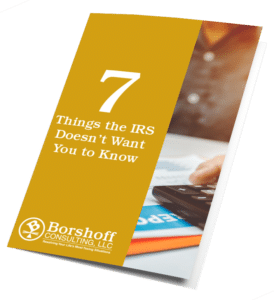If you live in Indiana, you’re likely familiar with the general taxation system. That is, if you earn money, you probably owe taxes on it. The money you make from your investments is no exception.
With investments, as with other income sources, the rules for paying taxes are specific and varied, depending mainly on the type of investment income and payout frequency.
As always, we at Borshoff consulting recommend making an appointment with a certified tax consultant when paying taxes you are unfamiliar with to ensure the appropriate paperwork is filed and you comply with all state and federal regulations.
Until then, this article should serve as a basis to get you started.
What is Investment Income?
Investment income is a form of income that comes from payouts that one receives as a result of valuable holdings they have. This can be paid in period dividends or as a net gain made when the investment is sold.
Types of income that might be considered investment income are interest gained through bank (notably savings) accounts, dividends received from stock ownership, and profits made from selling gold and silver coins. Investment income is also taxed at a different rate from earned income.
Taxes on Dividends
One of the most common investment income tax types is dividend taxes. With dividend taxes, there are two types you should be aware of: qualified and non-qualified.
Qualified dividends are paid out from companies based in the U.S. or in a country that has a double taxation treaty with them.
On these types of dividends, shareholders receive a preferential tax break on account of the company having already paid taxes on the income. Because of this, qualified dividends are taxed at a maximum rate of 20%.
For non-qualified dividends (those received from foreign companies without a double-taxation treaty), shareholders who receive them must pay taxes at the standard federal income tax rates.
It is also important to note that shareholders may only receive the preferential tax rate if they’ve held the stock for a minimum of 61 days in a pre-specified 121-day period, according to the Internal Revenue Service.
Taxes on Earned Interest
In the federal government’s eyes, most interest is subject to a simple income tax based on the marginal rate the investor is responsible for paying (the tax rate applied for each additional dollar of income). The exception to this policy is interest earned on bonds issued by the U.S and its municipalities.
This is because most of these bonds are federally tax-exempt, and many are also exempt from state taxes. Because of this, most investors prefer these types of municipal bonds to any other kind. Though the interest rate on them may be lower initially, the after-tax (or net) returns are often higher than that of other bonds.
Taxes on Capital Gains
Capital gains are what most people think of when they think about investment income. This form of investment payout refers to the money received when an investor purchases a stock and later sells it at a higher price.
The United States’ levy on capital gains is dependent on how long an investor has held that particular stock, as well as what their current income and filing status is. For long-term capital gains (longer than one year), the tax rate varies between 0%, 15%, and 20% and is based on how much taxable income that individual has and their tax bracket.
For short-term capital gains (less than one year), your capital gains are taxed at ordinary income tax rates, which are generally higher than the long-term rates.
However, investors may minimize their tax liability by taking advantage of the capital losses credit when filing their regular tax returns.
This tax credit allows investors to claim up to a $3,000 deduction depending on how much they incurred in capital losses during that particular year. This amount is cut in half to $1,500 if you are married and filing separately.
Do I Have to Pay Investment Taxes?
The short answer to this question is yes, you do.
The IRS requires you to report and pay on any tax liability you incur throughout the year, even if it is through investment income. Not doing so can land you in trouble, and you could find yourself receiving a letter from the IRS that results in fines or possible jail time.
For this reason, we recommend setting aside money each month on an estimated basis. That is, if you estimate you’ll owe $10,000 in taxes at the end of the year, divide that number by twelve and put that much back into a spare account every month.
Once you do this, you mustn’t look at that money as spendable—after all, it already belongs to the government.
However, if at the time you’re reading this article, you already have several months behind you where you didn’t put back the necessary funds, and it seems impossible to catch up, don’t fret. You aren’t entirely helpless.
If the amount you owe in taxes is less than $10,000, you can IRS Form 9465 or apply online for an installment agreement. If you’re approved, the IRS will allow you to pay that hefty tax bill in smaller biweekly or monthly sums until you’re caught up.
Conclusion
In summary, investment taxes span across several different types of income. If you let them go unchecked and don’t save for that final, end-of-year bill, you can find yourself staring into the face of a massive financial deficit.
Not to mention that not paying your taxes can result in fines, jail time, and sometimes both.
If you’re unsure of how much you need to save or how you’re supposed to pay, we recommend contacting a tax professional that suits your needs. At Borshoff Consulting, we fit the bill.
We offer professional tax services for filings, audits, and much more. If you have questions regarding your investment taxes (or any other tax matters), reach out to us today.





